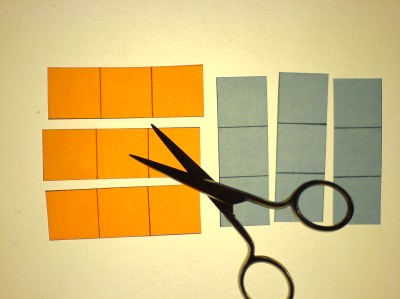

At the heart of digital signal processing is linear algebra, 'matrix
algebra'. And at the heart of linear algebra is the inner product.
Linear algebra is a huge area of research, most of of which I do not
understand at all. Fortunately the inner product is a simple concept,
and from there you can penetrate into deeper levels of the subject.
On a previous page I illustrated how matrix multiplication is a matter
of cutting the things into rows and columns and find the correlations
of these vectors. Here is a cut 'n paste from that page to refresh. The
inner product is the sum of products of corresponding vector
components. The result is one number that tells the measure of
correlation between the vectors; how much they have in common.
 |
 |
Finding an inner product of vectors can serve various purposes:
- you want to analyse the correlation of the vectors
- or you want to manipulate the content of vectors
The correlation of two vectors can be a positive or negative number,
or it can be zero. It can be a complex number too, in case the arrays
are complex. Speaking of complex
numbers: these have a special connexion to the concept of inner
product.
Let us take a close look at complex multiplication again. It is a
simple but very significant process. Here is (a+ib)(c+id) in it's two
equivalent matrix incarnations (yes, complex multiplication is
commutative):
 |
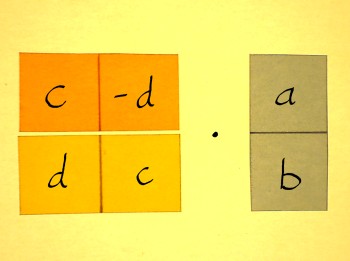 |
Choose an arbitrary example for (a+ib): (0.8+i0.6). Instead of doing
the complex multiplication with (c+id), we will now inspect the content
of the 2x2 matrix and calculate the inner product of it's rows.
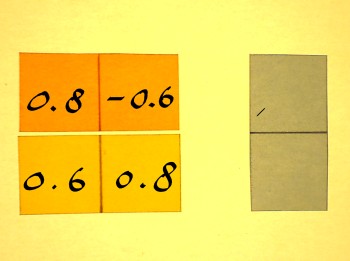 |
 |
It is zero. And it will be zero for the 2x2 multiplication matrix of
any complex vector (a+ib). Apparently,
during complex multiplication a complex vector is represented by two
other vectors, and I will draw these to check what they look like:
 |
(a-ib) is called the 'complex conjugate' of (a+ib). It is the
reflection of (a+ib) over the x-axis. (b+ia) does not have a
distinguished title like that. It is just ehm... the flip of (a+ib).
Anyway, (a-ib) and (b+ia) are perpendicular vectors. They call that:
orthogonal. And we have seen the inner product of these vectors: zero.
Orthogonal vectors have inner product zero. The 2x2 matrix of complex
multiplication is an orthogonal matrix, because the vectors in it are
orthogonal.
While perpendicularity or orthogonality can be visualised for the
case of vectors with two components, this is impossible for vectors of
more than two components. From here on, we must extend the concept
algebraically. The inner product tells the correlation of vectors, and
a correlation of zero means orthogonality.
The question is: what does orthogonality 'look' like, for vectors
with 2+ components? For vectors with an even number of components, it
is quite
easy to identify a vector perpendicular to it. Let us do an example
with vector (a,b,c,d). First flip the vector, that means, present it
time-reversed.
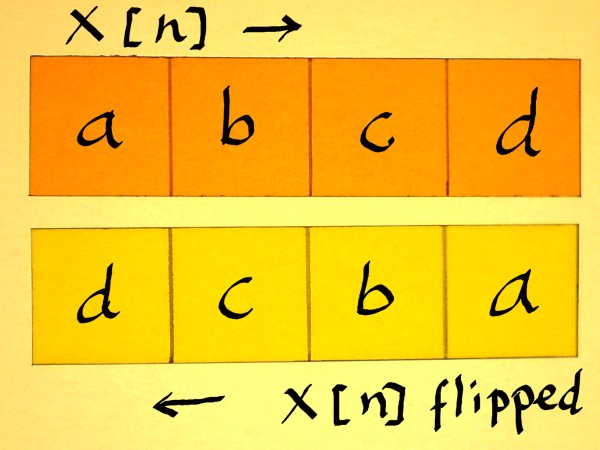 |
The flipped vector must than be alternated, which means it is
multiplied with 1 and -1 alternating. This can also be expressed as
multiplication with (-1)n. Which is -10, -11,
-12 etcetera, assuming that indexing x[n] starts with n=0.
 |
These vectors are orthogonal, no matter what values a b c and d
have. Let us check this. Choose some arbitrary values for x[n] and
alternate-flip
the vector:
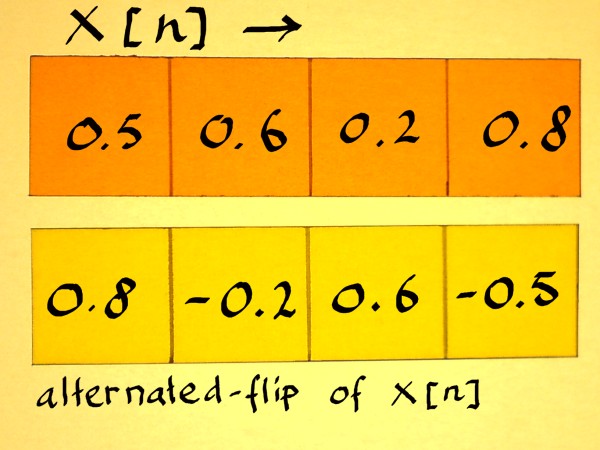 |
Then compute the inner product:
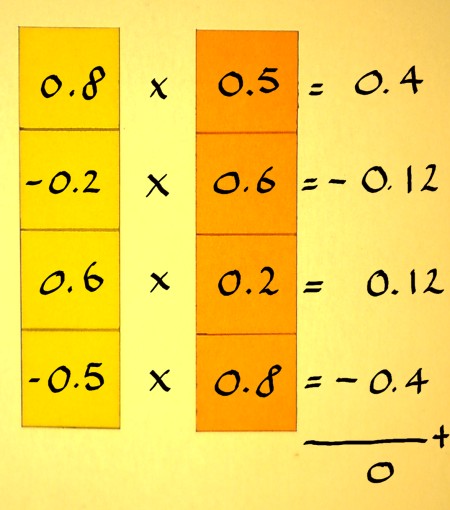 |
The inner product is zero, so the vectors are orthogonal indeed. The
alternate-the-flip method will work for any vector with an even
number of components, no matter what it's values are. This could be
applied to make orthogonal half-band filters. These may (and will) have
overlap in frequency response, but because of the orthogonal filter
arrays, the splitted signal is perfectly reconstructible.
Orthogonality is a
big topic, and I will do a separate page on that. But first we have to
inspect yet another feature of vectors:
they have a 'length', comparable to complex vectors having a radius
length. Such length is rather called 'norm', to indicate that it is
more
abstract than a fysical length. Furthermore, it is not the array
length. So from here on I will speak of: vector norm.
The first step in computing the vector norm of x[n] is finding an
inner product again. In this case, the inner product of x[n] and x[n]
itself. Does that have a special name? I don't know. The inner-inner
product?
 |
Write the inner product of it:
 |
Here we have a signal squared, x2[n]. It is equivalent to
the total energy in a signal (though not in the stricter sense of
alternating
current, because we did not specify any DC-filtering).
The second step, which finally results in the vector norm, is
finding the square root of the sum of squares:
 |
That has a remarkable similarity to computing the radius length of a
complex vector. A radius
length is to be considered a vector norm as well. I tend to think of
vector norm as 'Pythagoras extended'. Pythagoras extended to vectors
with more than two components.
The above described vector norm is called: L2 norm. Other
norm-definitions are conceivable. For example, L3
norm would mean the cube root of the sum of cubes. But in linear
algebra, we are computing inner products of two vectors at a time, not
three vectors or whatever. Therefore the L2 norm is the
relevant norm.
Like complex numbers on the unit circle, all vectors with vector
norm 1 are unit vectors. Unit vectors are of special importance,
because they do not alter the norm of a target vector, in matrix
multiplication. This may be a requirement in an operation, or if not,
it may still be a reference point. Therefore, it is interesting to see
how we can scale a vector with arbitrary norm to a unit vector. The
procedure is said in a couple of words: divide the vector by it's norm.
Let us do some simplistic examples to see the pattern in it. The first
one is a complex vector (1+i1):
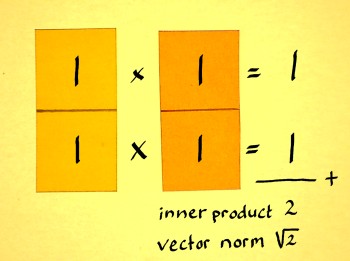 |
 |
The result is a complex number on the unit circle indeed, it is
(cos(pi/4)+isin(pi/4)).
Next I will do a vector with four components (1,1,1,1):
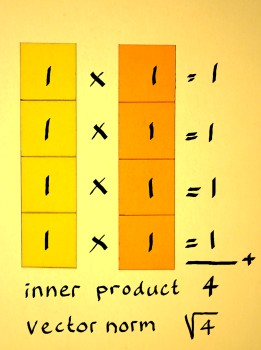 |
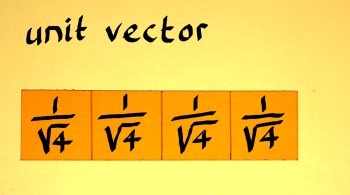 |
Now compute the norm of this new vector to check if it is 1 indeed:
 |
There are infinitely many unit vectors x[n] with four components of
course. Everytime I seem to choose the trivialest of examples. But that
is on purpose. The square-root-of-N arrangement, as it recurs in the
examples, comes in handy when you need to append known unit vectors
into larger arrays. Say you want to combine four arbitrary complex unit
vectors into one new unit vector. No need to compute the norm of the
whole thing first. Dividing all components by the square root of 4 will
do the job. If you want to append eight unit vectors, divide all
components by the square root of eight. Etcetera.